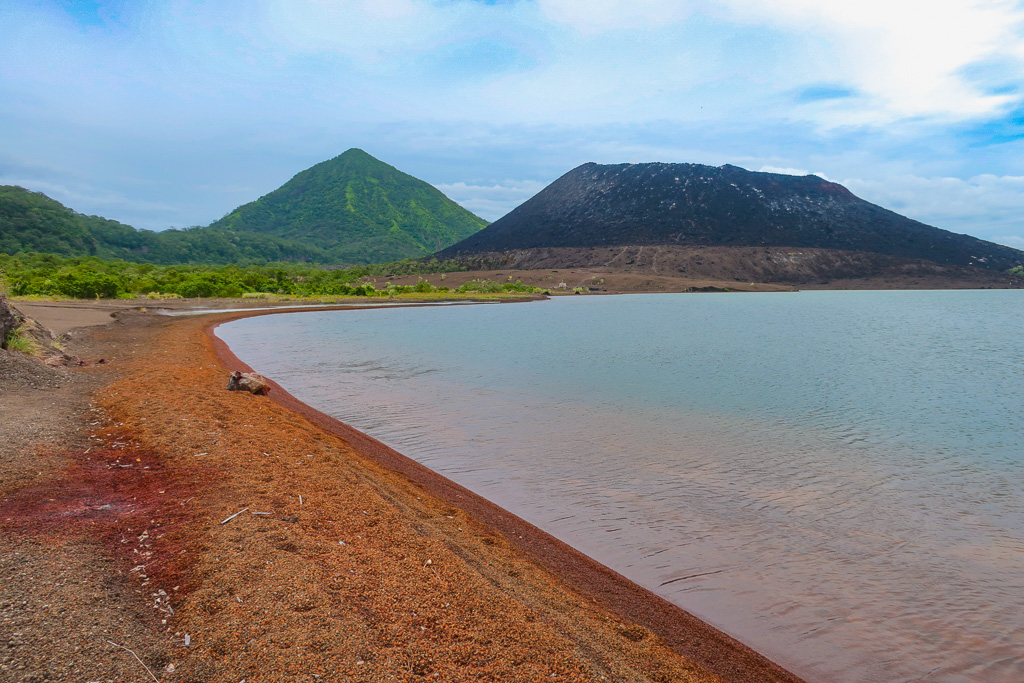
Everyone wants to take small risks in life, right? Or at least human nature can be doing something that others tell you that you can’t do? I guess this is the way I felt when I visited Papua New Guinea (PNG). This post outlines my experience one of the most culturally diverse and one of the fastest developing nations in the world. And I will share why I chose to stay in Rabaul, Papua New Guinea, and what made my experience a rewarding trip!
WAIT, BUT MY GOVERNMENT SAID I SHOULDN’T TRAVEL TO PNG
If you google American travel to PNG, you will find a travel warning for tourists to exercise extreme caution in the capital city of Port Moresby and a few other places. Of course the only way to travel to PNG is to travel through Port Moresby. However it is easy to book a connection to another destination within the country.
The main reason Port Moresby and some other parts of the country are not safe for tourists is because of the large gap between the middle class and the lower class. Many people from the outer areas of PNG move (or travel daily) into the city with hopes to earn more for themselves and for their families. Port Moresby and PNG are certainly making efforts to create infrastructure and jobs for their citizens.
But change takes time. So there are situations where people become desperate to make money, including holding up tourists. The best way to avoid this is to stay away from Port Moresby or if you must stay in the city, stay in a secure hotel, ensure you have pre-arranged transportation instead of taking local taxis, and don’t go out at night.
SO WHY GO TO PAPUA NEW GUINEA?
Trekking around the globe certainly is rewarding. Especially when visiting places that are off the beaten path and less traveled than other tourist spots. I had been to Vanuatu (see my post on Vanuatu as well as my post on stunning Tanna Island) and wanted to eventually go to the Philippines. The fastest route to get to the Philippines was a flight from Vanuatu to the Solomon Islands (see my post on the Solomon Islands), and then through Papua New Guinea and onward to Manila, Philippines, since there was no nonstop flights between Vanuatu and the Philippines. Since I was making a landing in each location, I thought I would explore these locations, including PNG, since most tourists only connect to other countries.
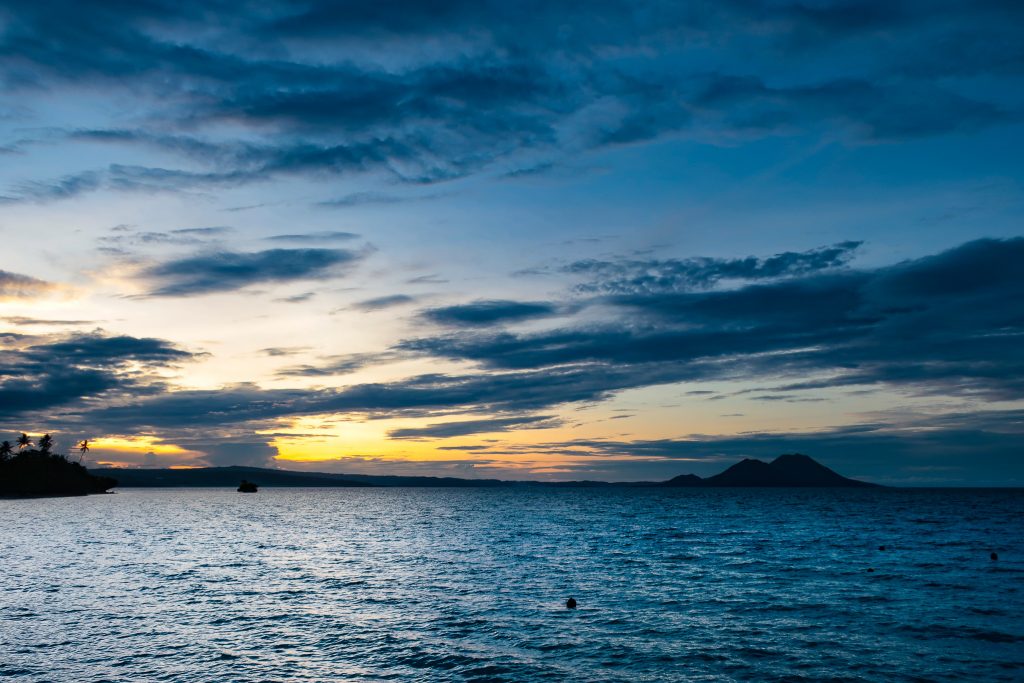
RABAUL WAS PERFECT DESTINATION
I had just climbed Mt. Yasur in Tanna Island, Vanuatu, and in doing some research, I found an easy accessible volcano to climb in Rabaul on New Britain Island. And Rabaul is filled with WWII history, geological history and great diving spots. Because of the rich history confined with geological beauty, Rabaul was the perfect spot for me to explore for a few days since I was in the area!
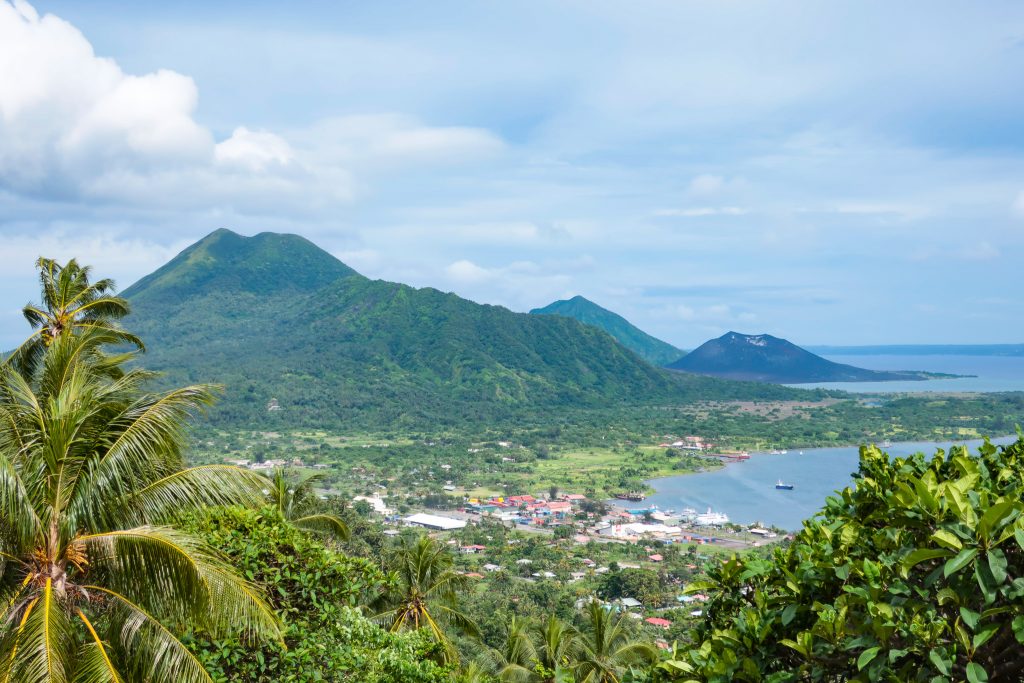
WWII HISTORY: TRACKING JAPAN’S MILITARY LEADER
After making the decision to bomb Pearl Harbor, Admiral Yamamoto who led the entire Japanese military came to Rabaul to hide out from the Americans. As history goes, the Americans eventually found him here. But it is an interesting story…
The Americans knew the Japanese built up their largest Pacific military base in Rabaul. It took a couple years to get there. It started back in Vanuatu where the Americans began building a large base on Santo Island (where I recently learned to scuba dive). Their strategy was to use that as a landing base to attack Guadalcanal Island, which is where the currently capital of the Solomon Islands, Honiara, is located.
Once the Americans overtook the Axis army in the Solomon Islands, they knew they now were in striking distance of Rabaul. And while all this was going on, the Americans has secretly tapped into communication of Admiral Yamamoto’s whereabouts. The Americans didn’t initially use this to attack but they tracked it for months to wait for the perfect opportunity to take him out.
AMERICANS ATTACK THE JAPANESE IN RABAUL
The Americans bombed the Rabaul Harbor and took out many ships. This was a huge turning point in the war as it weakened the Japanese Pacific presence. And the Americans also found the moment to take out Yamamoto when he left on a flight to go scope out a hiding spot on another island. The Americans intercepted his plane.
While I was in Rabaul, I entered several Japanese bunkers and also visited Yamamoto’s bunker where he hid for a couple years. I asked the locals what their families went through during the Japanese occupation of their land since their ancestors certainly experienced the situation. One of my bus drivers told me his family went high into the mountains to escape and hide. He told me that the locals still believe the Americans are the heroes since they got them their land back by taking out the Japanese.
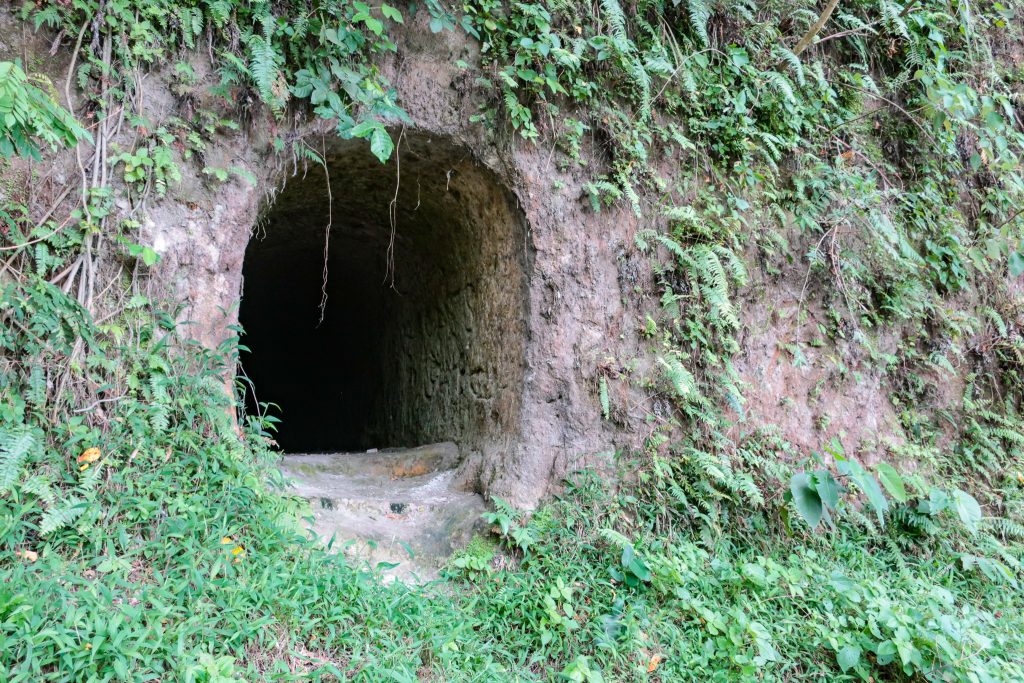
One of the other interesting facts I later learned that one of the ships that escaped and survived the Rabaul Harbor bombing by the Americans was eventually taken out two years later in the Coron Bay attacks. And was one of the shipwrecks I dove while I was in the Philippines. It was cool to know the story of the ship and how it was once in Rabaul where I had previously visited! And then there I was, diving in the middle of the tanker as it laid on the bottom of the bay.
RABAUL SITS ALONG THREE FAULT LINES
Rabaul is on New Britain Island which lies along not one, not two, but three fault lines. The entire island nation sits along the ring of fire but Rabaul is positioned in a spot where it receives many earthquakes. The main island of PNG had received two large earthquakes days before I arrived that created landslides causing many deaths.
On the flight to Rabaul, I sat next to a Scottish expat who was telling me about the fault lines and that the town is a prime target for a tsunami. Great! Earthquakes and Tsunamis! Scary but exciting at the same time.
WHOA THAT WAS AN EARTHQUAKE
On my first night in Rabaul, experiencing my first earthquake days earlier in the Solomon Islands, I was getting ready to go to bed, when the entire hotel room on the second floor began to shake. The wall hangings started to move. The lamps on the walls started shaking. The floor started shifting. It took me a couple seconds to process and I ran out of my room to the outside hallway. At the same time, two of my best door neighbors ran out of their doors. By the time we had gotten out of the room and onto the balcony hallway, the shifting had stopped
We were all breathing a little harder than normal and were grabbing onto the balcony railing. We looked at each other with nervous smiles and all knew what had just happened. That was scary, but I ended up making a good friend out of it. The next day, my neighbor and I hiked up one of the local volcanoes!
RABAUL WAS ONCE BURIED IN OVER 20 FEET OF VOLCANIC ASH
On the evening of September 24, 1994, the Mt Tavurvur volcano erupted along with another local volcano and buried the entire town of Rabaul under 20 feet of ash. Almost all of the buildings were destroyed due to the weight of the ash crushing the roofs and making the building collapse. Luckily there were no deaths because the volcano began smoking 24 hours in advance and the locals had time to evacuate.
Since the eruption, they have relocated the town further west to where the current Rabaul town sits. I stayed in the Rabaul Hotel which is one of the few structures to survive eruption. But it was eerie because the hotel was the only structure that sat along what was once the main 4-lane road through town. Today the road exists but there is about 10 feet of ash on both sides where buildings used to be.
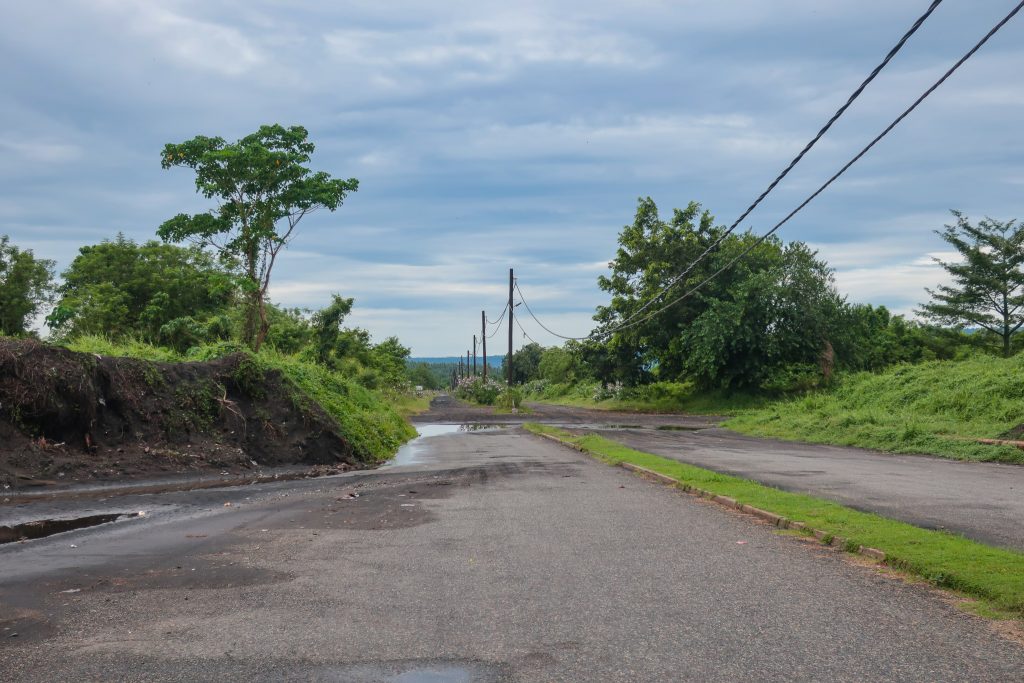
HIKING THE VOLCANO THAT BURIED RABAUL
The volcano has not been active since 1994 so people are able to hike up to the top. My new friend from Australia that I met the night before and I decided to hire a guide to take us to the summit!
Of course our guide had flip flops to go hiking! Hilarious. And we had to pay three different local entrance fees as we passed over the owner’s property. They literally had built two posts with a small wood stick they would lift up to let us through after we laid the small fee. It was comical because we could have easily walked around the gate. I guess it was official when we paid so we got to walk through this simple gate.
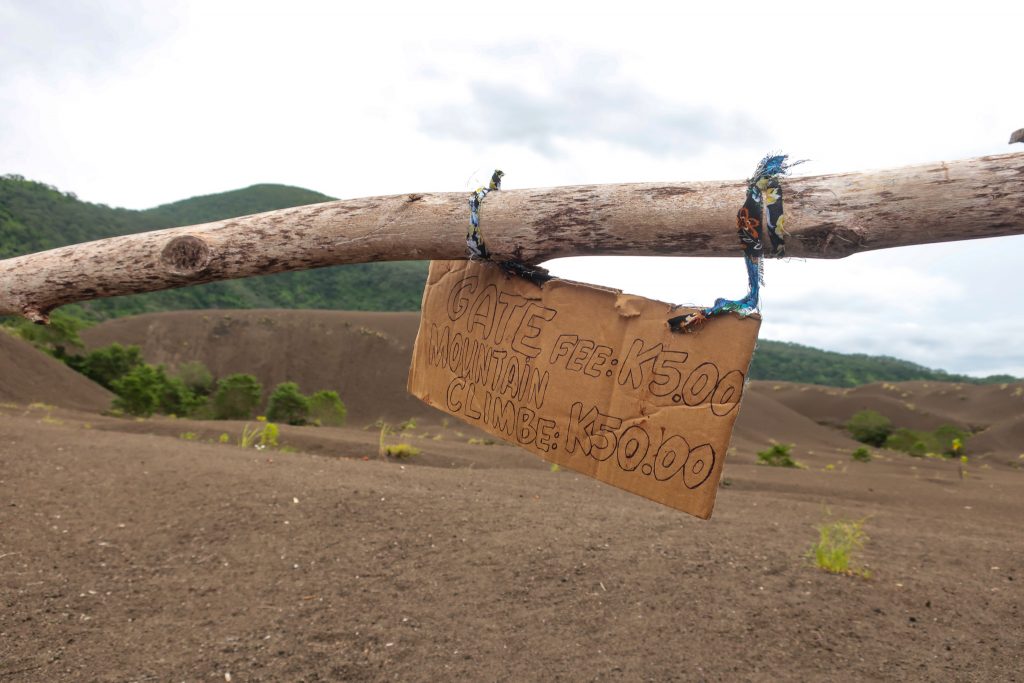
Along the path up to the base of the volcano, we saw huge lava bombs. Basically these were huge globs of lava the size of a small car that were at one point launched out of the volcano. You could see the crater where it landed and then rolled a few feet out.
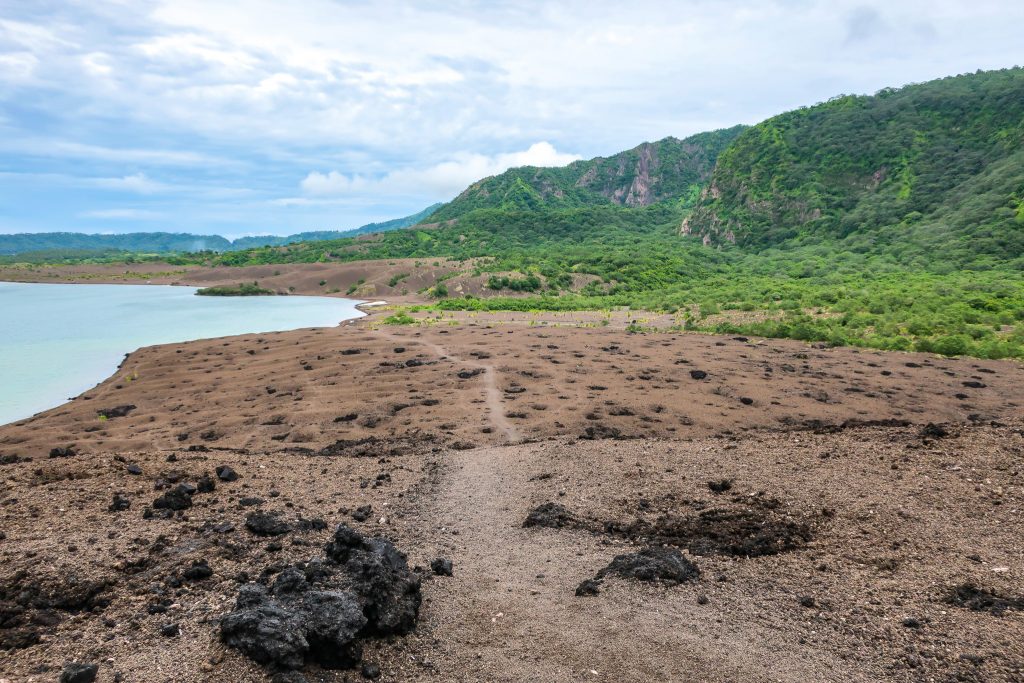
STANDING ON THE EDGE OF A VOLCANO THAT ERUPTED NOT TOO LONG AGO
Then the climb began. The path was all lava rock and ash so it was very loose. It was hard to get footing on the way up. The intimacy climb was not too steep however about halfway, the volcano sloped much steeper. My friend didn’t feel well so she rested on a rock while the guide (still in flip flops) and I (in hiking shoes) made our way to the top. I lost my footing a couple times but was able to regain it.
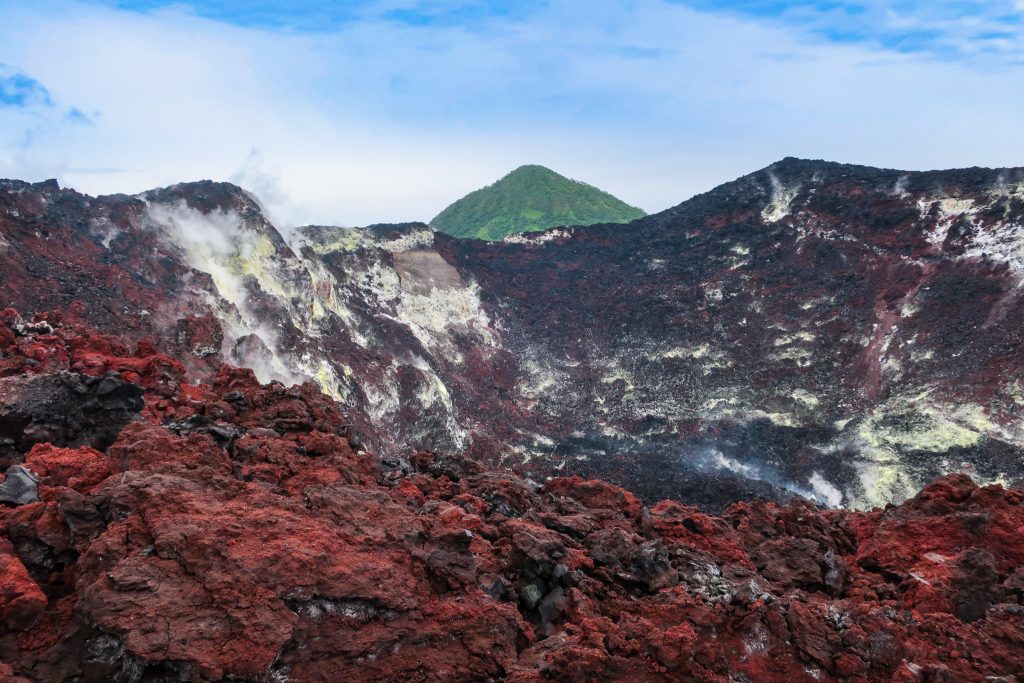
After an brief exhausting climb that took about 30 minutes total, we arrived at the edge of the volcano rim. Pure beauty. Steam was coming out of the inner walls of the volcano where it turned almost a fluorescent yellow color. And as I looked along the rim, it looked like the red rock was breaking apart in rows and falling inward. You could see consecutive cracks that almost resembled an accordion being pulled apart. I realized I was standing on one of those ridges. Like if there was an earthquake, the ridges would just all roll into the volcano. After some great photos, we made our descent and headed back into town with the help of a local private motor vehicle (also know as their local bus).
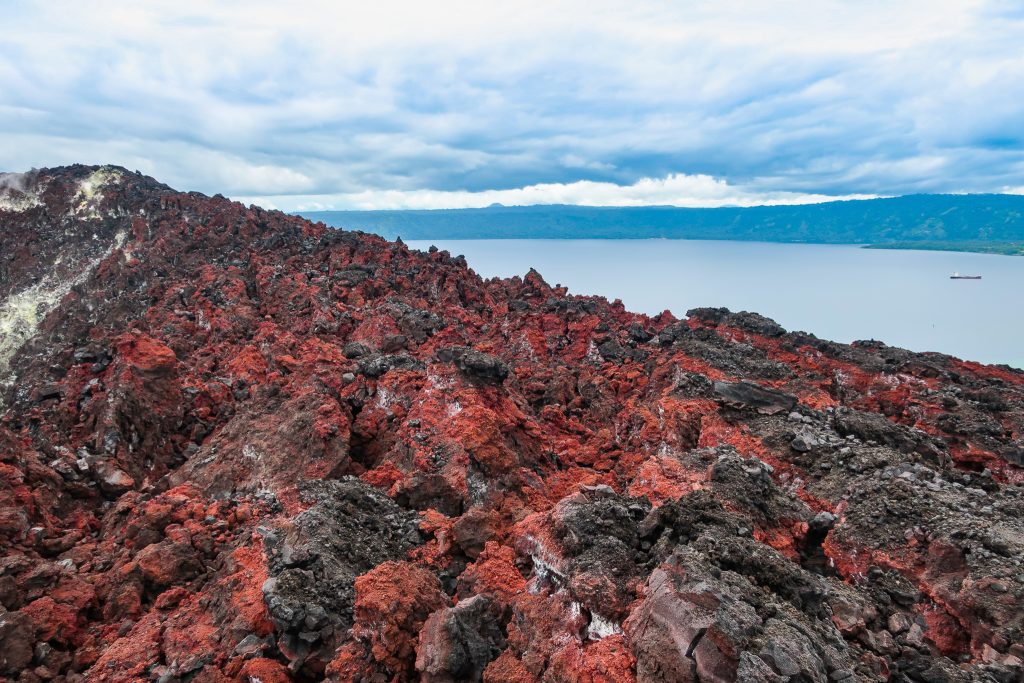
DON’T RELY ON EXPENSIVE, LOCAL AIRLINES
The cost of the local carriers to fly out from Port Moresby to other domestic destinations is extremely pricey. I believe this is another reason why International tourists avoid traveling to PNG. And, I also learned first hand that airline I booked, Air Niugini, is not reliable after hearing about this from locals.
I booked my flight departing Port Moresby on specific days because the airline only had one flight a week to Bali. The connecting flights were daily but I had to make sure I made my first flight to make my connecting flight. On the day of my departure, I took a local transfer from my hotel that was an hour to the airport. I had checked in and learned an hour later that my flight to Port Moresby was canceled! I would miss my connecting flight to Bali.
THANK GOODNESS I HAD PLENTY OF FLEX TIME
The airline rebooked me on an early flight to Port Moresby the next day to connect in Cairns, Australia, and then to Bali. They put me up in a really nice resort and paid for all of my meals! The next day, the early flight to Port Moresby was delayed so they rebooked me on a flight that would only give me an hour to connect to a flight in Singapore with an overnight and then to Bali the following day.
The Port Moresby flight was delayed longer than expected so when I arrived in Port Moresby I would miss my flight to Singapore! So the airline again rebooked me on the same Singapore flight the next day and then arrive in Bali the day after next. I demanded I fly business class on the 767. After many hoops to jump through, they gave me a free upgrade due to the disruption.
STAYING IN DANGEROUS PORT MORESBY
But now I was staying overnight in Port Moresby, something I tried to avoid. However my stay and food in Port Moresby was paid for by the airline and I had access to a nice gym!! And the entire hotel complex was heavily guarded as it was an international hotel: The Holiday Inn. This was perfect, even though I would arrive in Bali three days after I had planned. But it was great to have three hotel room nights and food in nice hotels with gyms all paid for! Thank goodness I am not in a hurry! Lesson: allow plenty of flex days of travel when traveling around PNG.
PNG: OVERALL GREAT VISIT
Even though I wasn’t able to go diving in the world class diving location filled with shipwrecks and beautiful reefs, I enjoyed my time in PNG. I felt safe the entire time and felt the people I met were very friendly. The country is rich in history and beauty!
Have you been to Papua New Guinea? Share your travel story below in the comments to help other travelers consider this diverse destination. Or do you have any desire to go to PNG? Maybe I can help – shoot me a note below.
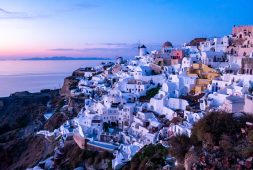
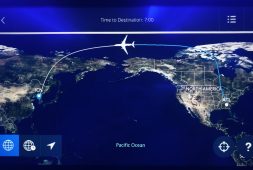
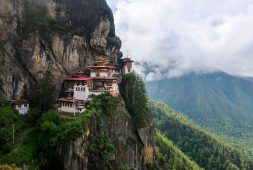
I made a trip to png in the late 70s. We took a small
Plane to rabaul for the day. It was fascinating. We
Hired a land rover and started to explore. A native went with us and we saw a Japanese zero plane
Stuck in the ground where it had landed..a native took us through the Bush to find it, not a tourist destination.
He was chopping the brush with his machete to get us to the plane. We saw the volcano, what a magnificent view. Highly recommended but found port moresby
To be frightening. Starting with the airport, lots of scary
People hanging outside. Went to lay, new Guinea also
Quite interested went to a village there. Only Australian visitors back then.